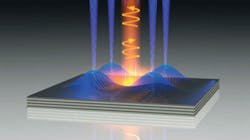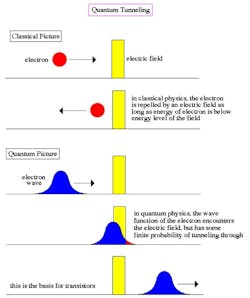As technology progresses, systems-on-a-chips continue to get smaller for increased computing power in advanced electronics. But when the size and spacing of transistors begins to approach the size of electrons, electrons begin to quantum tunnel between the thin walls of transistors, even when they are in their “off” state. This makes electrical signals unpredictable and decreases the reliability of the chip for computing.
In an effort to keep up with Moore’s law—though Intel says it is slowing down—scientists research new means to generate signals across extremely small chips. Researchers at the University of Cambridge investigate a condensed state of matter referred to as “liquid light”, which is made up of quasiparticles called polaritons. Derived from an electromagnetic wave coupled with excited energy quanta, these polaritons have a distinct spin value that the scientists could manipulate for spin encoding.
Before starting the experiment, the scientists needed to create a system that would polarize and quantize light. They used a semiconductor containing electron-hole pairs at its surface. These pairs, called excitons, have a dipole electric field. By running an electric field through the semiconductor, the excitons aligned themselves in a single direction along the gradient of the field. The scientists then placed the semiconductor with the aligned excitons in a micro-cavity with reflective walls, and shined light on it.
The micro-cavity width measured half of a wavelength of the light, so that it created a single standing wave as light bounced between its walls. Because the frequency of the standing wave matched the energy of the excitons in the semiconductor, they interacted to generate polariton quasiparticles in a state that simultaneously switched between standing waves and particles.
The video below from LDSD illustrates how polaritons are formed.
But in order to turn the polaritons into a liquid sample of particles, the scientists needed to conduct the experiment at cryogenic—very cold—temperatures. As all kinetic energy slowed to near-zero, the polaritons began to act more like localized particles, rather than a wave-particle duality with unpredictable motion and position. And at near zero temperatures, the polaritons began acting more like a dense liquid—a Bose-Einstein condensate. Furthermore, the condensate had distinct spin properties that could be controlled simply by switching the direction of the electric field originally passed through the semiconductor.
The scientists hope that the ability to control the polariton's spin direction with an external electric field will make "liquid light" a viable tool in commercial spintronics. By investigating other materials that do not require cryogenic temperatures, they hope to develop logic switches that can be used in smaller spin-encoded gadgets with improved bandwidth and power consumption.
The findings were published in the Journal Nature Materials.
About the Author
Leah Scully
Associate Content Producer
Leah Scully is a graduate of The College of New Jersey. She has a BS degree in Biomedical Engineering with a mechanical specialization. Leah is responsible for Machine Design’s news items that cover industry trends, research, and applied science and engineering, along with product galleries. Visit her on Facebook, or view her profile on LinkedIn.


